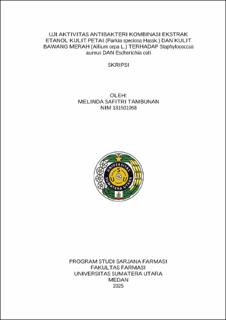| dc.description.abstract | Background: A major health problem today, not only in Indonesia but also globally, is infection. Infections are caused by bacteria; Staphylococcus aureus and Escherichia coli are two examples of bacteria that can infect humans and cause infectious diseases. The skin of shallots (Allium cepa L.) and petai (Parkia speciosa Hassk.) which have been studied for their antibacterial properties.
Objective: To determine the antibacterial activity of ethanol extract of shallot and petai skins against Staphylococcus aureus and Escherichia coli in single and combination administration. Methods: In this study, the manufacture of simplicia powder, characterization of simplicia (determination of water content, water-soluble extract content, ethanol-soluble extract content, total ash content, and acid-insoluble ash content), phytochemical screening, extraction of ethanol extract of shallot and petai skins using the maceration method using 96% ethanol solvent, and antibacterial activity test of the extract in single and combined concentrations using DMSO into several concentrations, namely 100 mg/mL; 10 mg/mL; 1 mg/mL; 0.8 mg/mL; 0.6 mg/mL; 0.4 mg/mL; 0.2 mg/mL for single administration, then use the minimum inhibitory concentration of single administration as the combined concentration. With a positive control of 30 mg/mL chloramphenicol against Staphylococcus aureus and Escherichia coli using the paper disc diffusion method (Kirby-Bauer test) to obtain the inhibitory diameter. Results: Examination of the characteristics of dried powder on samples of shallot skin obtained water content of 8.65% and petai skin 7.29%, water soluble extract content of shallot skin 16.05% and petai skin 18.16%, ethanol content of soluble extract of shallot skin 14.88% and 20.01% petai skin, total ash content of shallot skin 0.90% and petai skin 1.44%, and acid insoluble ash content of shallot skin 0.42% and petai skin 0.24%. Secondary metabolites including flavonoids, alkaloids, tannins, saponins, glycosides, and steroids/triterpenoids were found in the simplex and ethanol extracts of shallot and petai peels based on phytochemical screening results. Antibacterial activity tests against Escherichia coli and Staphylococcus aureus showed that the combined extract concentration produced the same bacterial inhibition zone as the single extract concentration. Conclusion: Ethanol extracts of shallot skin and petai skin have antibacterial activity when given as a single extract, and if the extracts are combined, the inhibition zone will be the same as the single extract test against Staphylococcus aureus and Escherichia coli. | en_US |


